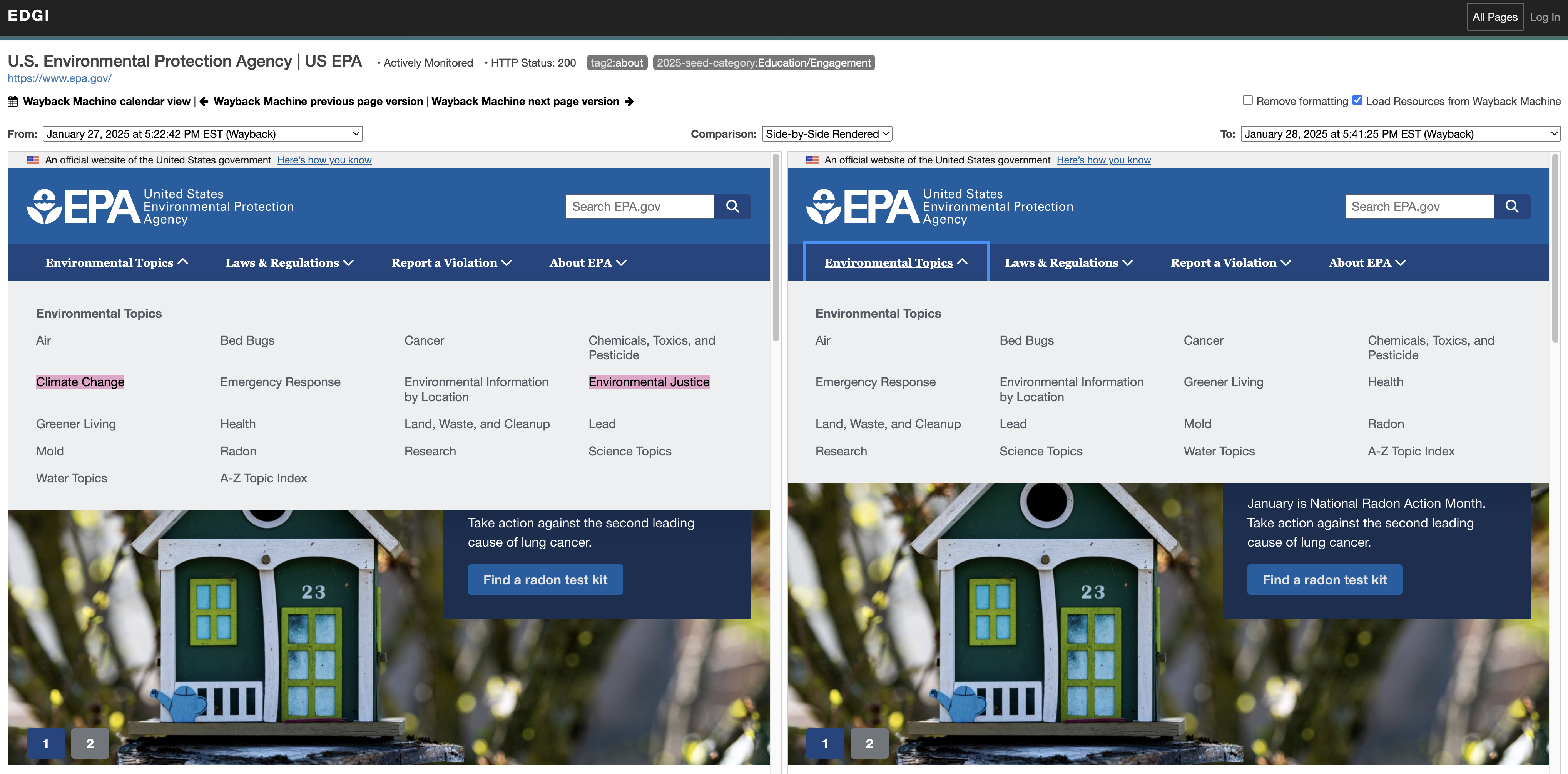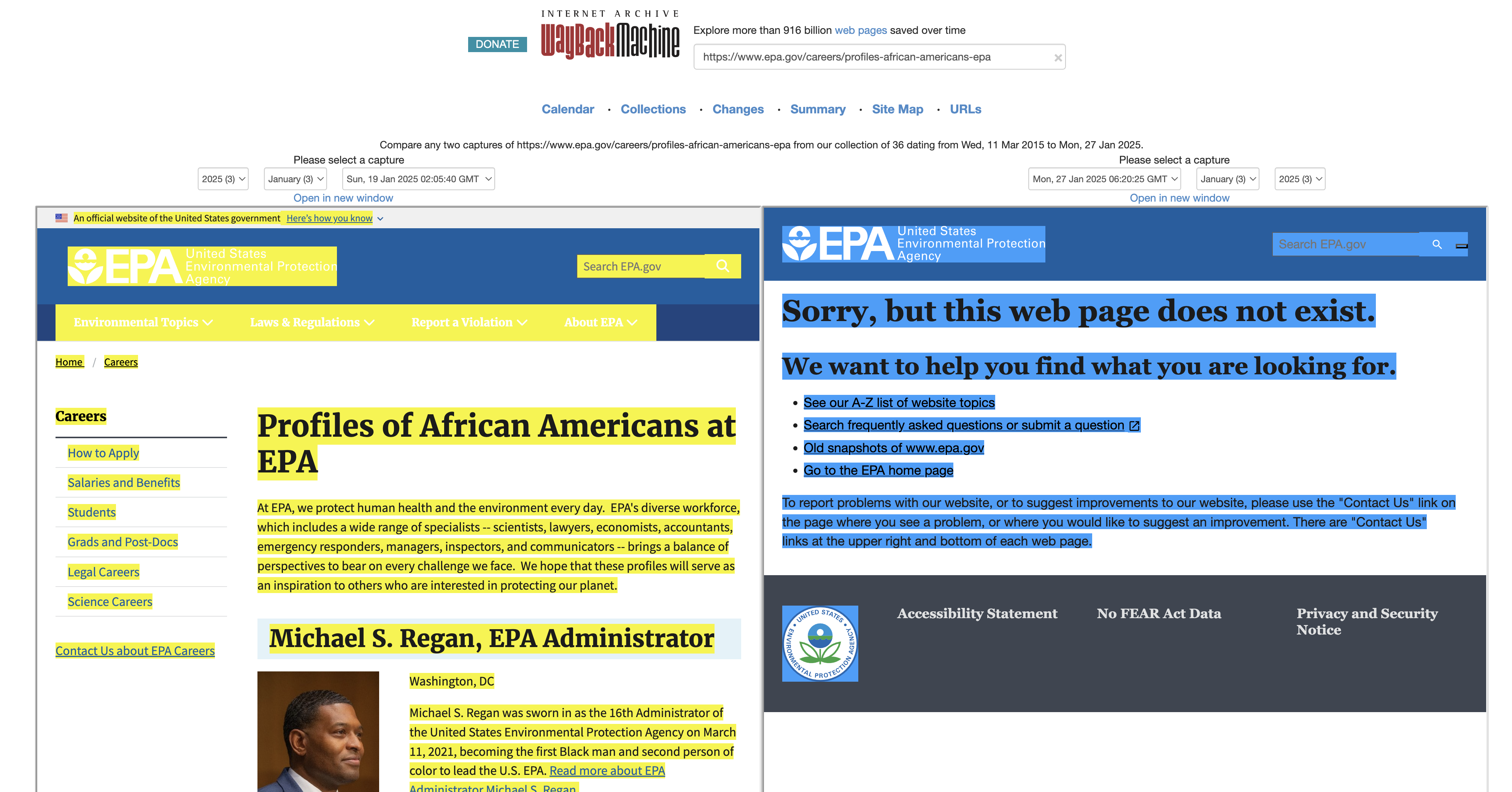When the White House took down a critical environmental justice tool just three days into President Trump’s administration, a team of data scientists and academics sprang into action.
They had prepared for this exact moment, having created a list of 250 online resources widely expected to be taken down during Trump’s second term. The Climate & Economic Justice Screening Tool, a platform created to help federal agencies, states, and community organizations, identify neighborhoods heavily burdened by pollution, topped the list. The team worked quickly to recreate the tool using previously archived data and host it on a new website. Two days later, the webpage was up and running.
In the two weeks since Trump’s inauguration, his administration moved swiftly to scrub government websites of information it objects to. Federal agencies have taken down critical environmental and public health datasets. The U.S. Global Change Research Program ended the National Nature Assessment, a sweeping review of the nation’s flora and fauna and its benefits to humanity. Departments throughout the executive branch have altered websites to eliminate any reference to the inequities women, people of color, and other marginalized communities face.
Researchers and advocates whose work revolves around addressing these inequities and mitigating the impacts of climate change told Grist they find these changes troubling.
“One of the things that’s worrisome is when you start to take down resources like this, you start to construct a knowledge sphere that doesn’t acknowledge that environmental or climate injustices exist,” said Eric Nost, a geographer and assistant professor at the University of Guelph. Nost, who studies the role of data technology in environmental policymaking, is part of the Environmental Data and Governance Initiative, one of several organizations tracking the Trump administration’s changes to federal websites and resources.

Environmental Data Governance Initiative
Many of these changes are a direct response to executive orders the president issued within hours of taking office to end “Radical And Wasteful Government DEI Programs And Preferencing” and defend “Women from Gender Ideology Extremism.” Many of them dovetail with his rescinding a Clinton-era executive order requiring federal agencies to consider the impact of their policies on areas with high poverty rates and large minority populations. Trump also revoked Justice40, President Biden’s policy of ensuring so-called “disadvantaged” communities receive 40 percent of the benefits of climate and energy spending. Some of the resources dismantled in the past two weeks, including the Climate & Economic Justice Screening Tool, were created to help achieve these goals.
The Environmental Protection Agency deleted pages showcasing the work of African American employees. It also removed an equity action plan, the “Diversity and Inclusion” section on its careers page, and scrubbed “Environmental Justice” and “Climate Change” from its homepage menu. The Centers for Disease Control and Prevention took down data and resources related to trans people, HIV, and environmental justice. The Department of Energy eliminated online resources for anyone struggling with energy bills. The webpage previously listed government assistance programs like the Low Income Home Energy Assistance Program, which helps low-income households pay for electricity. The agency also killed its own version of the environmental justice screening tool.

Environmental Data Governance Initiative
Beyond making it harder for taxpayers to access information that could reduce their bills and navigate some of the effects of climate change, these steps make it harder to govern effectively. “Policymakers and the public and communities need good information to make the best policy decision, whatever that is,” said Carrie Jenks, the executive director of the Environmental & Energy Law Program at Harvard University. “To the extent that any administration is not using data or not giving access to data, that will always be of concern to us.”
The law program has been tracking the Trump administration’s rollback of environmental rules and environmental justice policies since his first term. A handful of other groups consisting of academics, archivists, students, and environmental organizations are pursuing similar efforts and have launched an initiative called The Public Environmental Data Project. The Environmental Data and Governance Initiative is part of the effort, as is the Internet Archive, a nonprofit that has since 1996 been archiving webpages, and End of Term, a group that has since 2008 archived federal websites at the end of each presidential administration.
Other environmental groups are archiving taxpayer-funded datasets at a smaller scale. For instance, the Urban Ocean Lab, a think tank that helps coastal communities design climate and ocean policy, began collating research and data on climate change in a dedicated section of its website last summer. The group started a “Resource Hub” to help cities easily identify the best available climate science. When Trump won the election in November, it realized that dozens of datasets and research hosted on government websites could disappear and began archiving additional policy papers and data. Those resources were especially relevant because the lab found many cities use outdated information to make planning decisions.
“We remember what had happened during the last Trump administration, where a huge amount of relevant environmental information was taken down or altered, and we wanted to make sure that the resources that we had posted to our own website would continue to live on,” said Alex Miller, an analyst there.
What’s happening now is in many ways a repetition of the efforts the Trump administration made during his first term, when as much as 20 percent of the EPA’s website became inaccessible to the public. The use of the term “climate change” decreased by more than a third. The first Trump administration also tried to derail work on the National Climate Assessment, an important synthesis of the state of climate science that shapes federal policy.
This time around, Trump officials are attempting to more tightly control how the assessment is compiled and want to lower the scientific standards it employs, according to reporting by E&E News. While the document is likely to be published in some form within two years, the administration did axe another environmental review.
Last year, the Biden administration announced the National Nature Assessment, a comprehensive literature review of the state of nature in the United States. It was modeled after the climate assessment and enlisted dozens of researchers to calculate all the ways nature is valuable. Last week, the administration told researchers who had spent nearly a year working on the report that it was shutting down the effort. Alessandro Rigolon, an architect and planner who teaches at the University of Utah and studies the benefits of green spaces, was working with other researchers to outline the effects of nature on physical and mental well-being. Rigolon said he was informed about the administration’s decision just a few days after a meeting in Vermont with those colleagues.
Because those working on the report were volunteers, Rigolon said they trying to find a way to continue their work.
“We are committed to writing this one way or another,” said Rigolon. “I almost see a resurgence in pride in this work and willingness to get it done after the work was terminated without explanation.”
This story was originally published by Grist with the headline The scramble to save critical climate data from Trump’s war on DEI on Feb 5, 2025.
“Policymakers and the public and communities need good information to make the best policy decision, whatever that is.” Politics Grist





